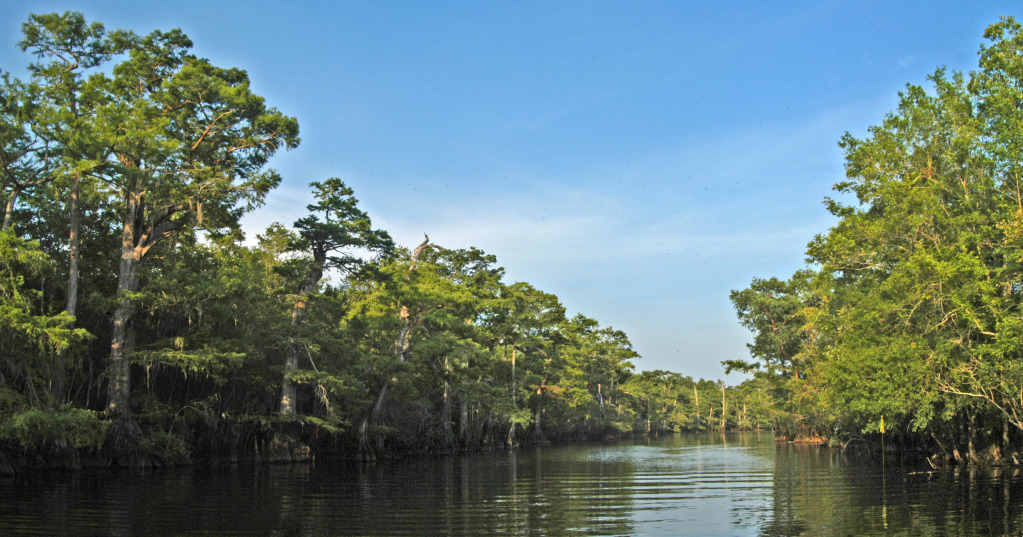
By Dave Stahle, Katie Wolfe, and Dan Griffin
NOTE: University of Arkansas Professor Dave Stahle identified the oldest trees east of the Rockies on North Carolina’s Black River in 1985. He recently revisited the area and wrote this article as a result.
The oldest baldcypress trees ever found are located on the Black River in Pender and Bladen Counties. Tree-ring dating, or dendrochronology, has been used to prove that some of those old baldcypress are over 1,500 years old. A few may be over 2,000 years old, but this will be difficult to prove because many of the oldest trees suffer some degree of heart rot. Nevertheless, only a handful of tree species worldwide have been proven to live for more than 1,500 years.
The exceptional age of the Black River baldcypress trees has been known since 1985 when we first extracted small core samples from some of the old trees (core sampling does not seriously harm these ancient cypress). Microscopic analysis of the annual growth rings proved their great age and measurements of the dated growth rings have been used to develop a chronology of growing season rainfall for North Carolina dating back to A.D. 372. We visited the Black River three times in the 1980’s and 1990’s, but did not appreciate the full extent of the old-growth baldcypress forests along the Black River or their significance to the conservation of this remarkable stream.
We returned to the Black River last June and got a much better impression of the true size and significance of these ancient cypress wetlands. It has been 20 years since our last visit and we were amazed to see so many super ancient cypress along the river. In many areas along the Black it is possible to turn in a circle and see 10 to 20 baldcypress trees over 1,000 years old. This density of millennium-old trees is rare in any forest worldwide. Although a dozen or so species can live for more than 1,500 years, most of these old growth stands have very few individual trees in the oldest age class. Not at the Black River. There are literally hundreds of millennium-old trees at the Black River, which has the largest concentration of ancient baldcypress trees we have ever found after 30 years of searching in the southeastern United States, Mexico, and Guatemala.
Ancient baldcypress stands can still be found along other streams in the Southeast, but not quite as impressively as on the Black River. These remaining ancient cypress stands do not necessarily include huge trees with valuable timber. Their “decrepit over-mature” condition, the result of recurrent drought and gale over the centuries, reduced their value for saw timber. During our June field trip we also visited a fine tract of ancient cypress trees on the Little Pee Dee River, South Carolina, with Dr. Maria Whitehead who is heading a Nature Conservancy conservation effort in the Winyah Bay and Pee Dee River Basin. It will be a big job, but these ancient cypress forest remnants ought to be systematically mapped throughout the Southeast. Knowing where these ancient forest parcels are located is the obvious first step in their conservation. Where possible they ought to be conserved for their beauty, biodiversity, and scientific value. They are among the last pristine examples of the pre-settlement environment in the Carolinas.
We had not realized how large the area of ancient cypress forest actually is along the Black River. During previous trips we had only surveyed about 300 acres, but The Nature Conservancy has helped to conserve over 11,000 acres along the Black River, and much of it includes remarkably old trees. The Black River retains some of the highest surface water quality in the state of North Carolina and has been named an outstanding water resource by the Department of Environment and Natural Resources. We were gratified to learn that our research on the ancient baldcypress trees was helpful in raising awareness and interest in the conservation of these irreplaceable natural resources.
But the highlight of our trip was the visit to the ancient cypress wetlands of the Black River, certainly one of the greatest natural areas left in the southern United States. It was hot and the river was low. The stream is choked with sand in the Three Sisters area, where the oldest identified trees have been found. It braids into several channels of whiskey-colored water flowing over white sands and among the gigantic baldcypress trees. A colony of wood storks has recently moved into the forest, reclaiming habitat lost during their near extinction. If these ancient forested wetlands can continue to be protected then we are certain that these efforts will be appreciated by future generations.

